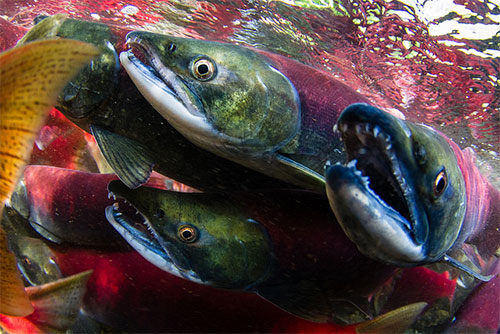
Despite evolutionary inexperience, northern sockeye manage heat stress
December 11, 2016
Sockeyes, which spawn in fresh water and spend two to three years in the Pacific Ocean, range from southern Alaska south to the Columbia River. Research by Oregon State University revealed that sockeyes at the northern edge of that range, despite lacking their southern counterparts' evolutionary history of dealing with heat stress, nevertheless have an innate ability to "thermoregulate."
Sockeye salmon
Multiple earlier studies had demonstrated thermoregulation behavior among sockeye salmon at lower latitudes, but northern populations' behavioral response to heat stress had largely gone unexamined. While it may seem obvious that any fish would move around to find the water temperature it needed, prior research has shown thermoregulation is far from automatic -- even among populations living where heat stress is a regular occurrence. "Often what's happened has been counterintuitive, so we had no idea what to expect," said Jonathan B. Armstrong, assistant professor in the College of Agricultural Sciences' Department of Fish and Wildlife, the lead author on the study. "About 40 million sockeye return to Bristol Bay every year. These huge salmon runs are a big part of the regional culture and economy, so how these fish respond to climate change will have very real effects on people's lives. It's encouraging that the sockeyes showed this innate capacity to respond." Results of the research were recently published in Conservation Physiology. Armstrong and his collaborators at the University of Washington worked in 2013 at Little Togiak Lake -- one of five major lakes in the Wood River watershed that drain into Bristol Bay, a fishery that produces nearly 70 percent of all the sockeye salmon caught in the United States. Bristol Bay is close to the 60-degree latitude that marks the northern boundary of the sockeyes' primary range. Adult sockeye salmon return to the Wood River system from the Bering Sea in early summer, then mature and develop secondary sexual traits before spawning later in the summer or at the beginning of fall. During the time between entering fresh water and spawning, the fish group together in their lake's epilimnion -- the upper, warmer level of water in a thermally stratified lake. Usually the fish congregate, or stage, near tributary inlets and along shorelines. During a staging period of unusually warm weather - maximum daily air temperatures hovered around 80 degrees for a week, the second-warmest heat wave on record - researchers used a seine to capture fish and outfitted 95 of them with devices that logged water temperatures at 20-minute intervals. What they learned from the 40 recovered temperature loggers was that when the epilimnion temperature rose above about 12 degrees Celsius, or about 53 degrees, the fish thermoregulated by moving to tributary plumes or to deeper water. By swimming away from the rising temperatures, the fish expended 50 percent less energy during the warmest conditions - 64 to 68 degrees - than they would have had they stayed put. "The hotter it is, the more energy they burn, but these fish don't just want the coldest water possible," Armstrong said. "If they were cars looking for maximum fuel efficiency, they'd just find the coldest water, but instead it's a Goldilocks sort of thing - they're looking for not too warm, not too cold. "They want their system to go fast enough for them to go through maturation before they spawn, where they go from these silver torpedoes to these crazy, exaggerated beasts of sexual selection with a red body and green jaws." Armstrong noted the broader message of the study is what it says about the ability of animals to exploit the kinds of diversity of temperature and diversity of habitat found in ecosystems that are intact and not heavily developed. "There's all this diversity and connectivity up there," Armstrong said. "Fish have lots of options for coping with warming or environmental change in general. "When we develop watersheds, we often simplify habitats and take away these options. In our research we are constantly stumbling across new and interesting ways that fish and wildlife thrive by exploiting diversity in temperatures, often at small spatial scales that would be very easy to overlook. This study is one more example of how all the little details matter, and they could be what save animals from climate change, or at least reduce the impacts."
Editing by Mary Kauffman, SitNews
Source of News:
Representations of fact and opinions in comments posted are solely those of the individual posters and do not represent the opinions of Sitnews.
|
||
